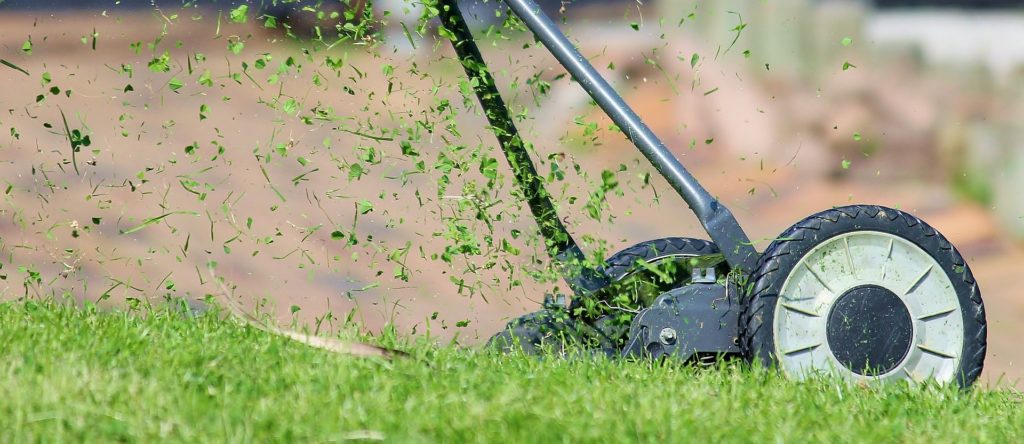
Sod is instant gratification for your lawn. (Well, maybe it’s not completely instant gratification, as you still need to do prep work to make the lawn ready to receive it.) Of course, being instant gratification, sod costs more to purchase and install.
On the other hand, after a day or two of work, plus a week of just-right watering, you get a luscious, thick green turf that looks like magic.
The very nice thing about sod is that somebody else – specifically, a team of people who knows a LOT about growing grass – has prepared this grass for the last 14 to 18 months, seeding it, feeding it, and blasting every weed that even tries to show its spindly head. So basically you’re paying to have a professional’s lawn installed at your house. Kind of a sweet deal!
Sod is also convenient. You can install it pretty much any time during the growing season. You don’t have to worry about weeds popping up the way you would when you’re sowing grass seed.
In the south, sod is often your main choice – some warm-season grasses (Bermuda grass, zoyisia, or centipede grass) can’t be grown from seed, but only via sprigs, plugs, or sod.
Now, if your lawn is shady, check to make sure you’re getting shade-tolerant sod. These lush sod fields are grown in full sun with not a tree in sight, and the grass strains they use for these fields are for full sun. However, some sod is grown exclusively for shade, so be sure to tell your sod salesman about the shade conditions in your yard so you can get the best turf for your buck. Shade-tolerant sod is great around trees.
Sod can cover a multitude of faults. It chokes out weeds. Sod is great if you have a slope that you need to cover quickly before it erodes away. And it’s ready to go in half the time compared to seeded lawns.
Or, if you have a bare spot in your yard where grass doesn’t want to grow, cut it out and sod it. It costs more but it’s an advantage. My father-in-law did that down at the lake. He got two rolls of sod, cut out the grass, laid the sod out, watered it, pff, done.

Buying Sod
You can buy sod at a nursery, a garden center, or directly from the sod farm itself. Be sure to do your homework when you’re buying sod, however, so you can make sure you’re getting a quality product.
Shop around for sod because it varies in price. It often depends on the farm it comes from. Sometimes if you call around, you might find there’s two dollars difference per roll. Prices are all over the place. But check on quality before buying.
Here are some pointers.
1) Measure your yard. You won’t buy a new carpet without having measured your living room, so measure the space where you want to lay sod and calculate the square footage. Some lawns are irregular – that’s fine, don’t kill yourself with math. Get a close approximation of the total square footage, then add about 5 or 10 percent onto that so the sod installers will have enough leeway to cut and shape the sod to fit your irregular lawn.
2) Buy local sod. If you buy from a sod farmer in the area, you know that you’ll be buying grass that does well in your climate and soil. This grass will do better than something that’s shipped from out of state.
3) Order sod a week before you plan to lay it. This gives the grower time to cut and ship a good product. Also, don’t order more than a week ahead. The sod should not sit out for more than 48 hours after it’s delivered, or you’ll start getting brown edges. Fresh sod is best.
4) Check the sod. Unroll a few sections of sod in your delivery and check for weeds, insects, diseases. A good company will deliver a clean product. If you see any of these things in your sod, send it back. You want clean grass; you aren’t paying for sod so you can fight dollar spot or grubs for the rest of your life. Also, check for signs of drying out – where the edges are browning or curling. It’s not your job to bring sod back to life. Finally, check the roots to make sure they’re white and moist. The sod should be cool to the touch. Sod that’s been sitting around for a while will start to compost itself, killing the grass. These rolls, when you unroll them, gives you grass that’s been darkened by the composting process. So if you can feel heat coming off the rolls, move on!
5) Also, the grass and its roots and soil should be thick enough to unroll and pick up without breaking. One time when I was at Parks, I was helping to lay sod at one of the baseball fields. The shipment we got was cut surprisingly thin. Some pieces would just come apart as we unrolled them, and we had to do our best to batten them together. I don’t think we were able to send that shipment back, because we were on a tight deadline to finish that field (and the sod was probably from one of the boss’s friends – so it goes).
Installing and Watering Sod
Once again, don’t lay sod before you’ve prepared the soil. Add topsoil and till it in if the soil is really bad, do a soil test, add and till in those good organic soil amendments that your soil test results recommends, level and grade your soil (have at least a 1:50 slope away from your foundation), pick up any rocks on the ground. Then you’re good to go.
It’s best if you start working as soon as the sod shows up. If for some reason you have to wait, have the delivery people put the sod in the shade, and mist the rolls so they don’t dry out. You can keep it rolled up for 24 or even 48 hours after delivery, but don’t press your luck.
Tools:
* A sharp utility knife, for cutting the sod to fit
* A wheelbarrow for trucking it around
* A water-filled roller, to roll the sod so it makes good contact with the ground
* Stakes for VAMPIRES. No, the stakes are to secure sod that you put on slopes
* A piece of plywood to stand on while you’re installing your sod (this eases compaction on the sod you’ve just laid)
* Flags. If you’ve had a sprinkler system installed in your yard, walk through now and flag every sprinkler head in the yard. You’ll need to cut the sod so the sprinkler heads will be able to pop up when they’re turned on.
Now you’re ready to start!
Find a nice, straight edge to start from, such as a sidewalk or a driveway. If you don’t have a straight edge, make one by stretching a string on stakes in a straight line across the middle of your yard, and start laying sod on both sides of it.
Gently moisten the soil as you work so the grass roots in the sod make contact with moist ground. Then unroll the sod and batten it up against the straight line you’re starting with. Set down the next roll so the end is directly touching the end of the previous roll, then unroll it. Then push the roll so its end is touching, but not overlapping, the other end. You want to make a nice smooth carpet with no gaps. Overlaps will make huge bumps in the yard that will bounce your lawnmower around. Gaps will leave brown areas where the crabgrass can pop through.
The sod can take a little rough handling, but don’t go overboard and tear it. It’s tough to batten together a torn piece.
Once you have the first row of sod laid, start the second row by laying it in a brick pattern. This keeps you from having long lines going across your lawn. Cut the sod around the edges of the lawn so it fits, and use these extra pieces to fill in areas where the sod doesn’t quite meet up, or where you have to cut out an area that looks bad for one reason or another.
Like a quilter, if you find a gap, set in a piece of sod that’s cut to fit the hole. Keep aside a few rolls of sod in a shady place, and use these rolls for repairs.
If you’re working on a slope, lay the sod across the slope, not up and down it. This helps to keep erosion down. Also, if the slope is particularly tricky, use stakes to hold the sod in place until it roots. Of course, mark each stake with a bit of red paint (landscaper’s spray paint is handy for this) so you can get every single stake out BEFORE you mow. Use the plywood, or a wide board, to kneel on if you have to work on the newly-laid sod. This helps distribute your weight evenly across the sod.
This is hot, dusty work. It’s not so bad in the morning, but once the sun starts climbing, you start to feel the heat. Be sure to have your water or your sports drink nearby.
If you start to feel dizzy or lightheaded, get into some shade and take a few minutes to cool off. Heatstroke and heat exhaustion are serious matters – if you do any kind of long-term work in the summer heat, be aware of the warning signs. One year during an especially hot August that was filled with 95- and 100-degree days, one man died of heat exhaustion while mowing his yard. Don’t become a statistic.
Once you’ve laid the sod, fill your roller halfway with water, then roll over the sod at a 90 degree angle to the direction you laid the sod. If you’ve laid a very large area, roll a section, water that section in, then move to the next section and repeat. While you’re rolling, walk carefully so you don’t accidentally pull up corners of the sod – or, worse, pull up a corner and then roll over it with the roller before you know what you’ve done.
And then, water. If you have a sprinkler system installed under the sod, now you can use it. If not, you’ll have to use a lot of sprinklers, or some really dedicated people with hoses. Water deeply, giving your new sod 3 to 4 inches of water in its initial watering. Be especially sure to water out to the very edges of your new lawn, paying close attention to the edges of the sod.
To check to be sure the water has penetrated, lift a corner of sod here and there and make sure the soil underneath is wet, then gently firm it back down.
Water the sod every day for the first week. Pay attention to the corners and edges – those are always first to dry out.
The roots start growing into the soil after the first week, so you won’t have to water so much – maybe every other day. Watch the color of the sod carefully when you dial back the water. If it stays green, great. If it doesn’t look as green, keep up the daily waterings for a little while longer. After three weeks, if all is well, you should be able water just a couple of times a week and be fine. (Of course, if you get a lot of rain, or if you’re hit with an incredible drought, adjust the watering schedule accordingly.)
There you have it! A lush new lawn that’s ready to go.
